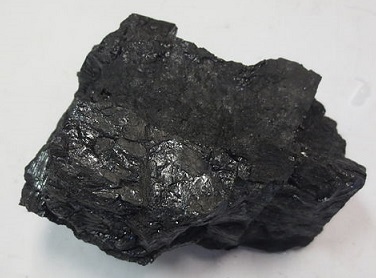Bituminous coal

Bituminous coal is mid-rank type of coal and a black fossil fuel. It is also the most abundant type of coal. The carbon content of bituminous coal is approximately 80%.[2] Usually, bituminous coal comes from fairly old coal deposits, usually around 300 000 000 years old. The energy density of this coal is relatively high - 27 MJ/kg, meaning that it releases a significant amount of energy when burned.[3]
Uses
The high carbon and low moisture content of this particular type of coal makes it ideal in the production of steel and cement, as well as in electricity generation and coke production.[4] There are two subtypes of bituminous coal: thermal and metallurgical. These two subtypes are used differently.[5] Thermal coal, also referred to as steam coalis slightly higher quality than metallurgical coal with a slightly higher carbon content. Specifically, thermal coal is used in power plants that produce steam for electricity generation. Additionally, steam powered trains were powered by thermal coal.
Metallurgical coal is referred to as coking coal and is used in the production of coke.[5] This coke is a source of carbon for making steel.
Hazards
Burning bituminous coal poses serious health risks. First, this type of coal produces excessive amounts of smoke and soot and its high sulfur content contributes to acid rain through the release of sulfur oxides (SOx). As well, bituminous coal can contain harmful impurities such as arsenic and mercury, and these impurities are released into the air as pollution when the coal is burned. Burning bituminous coal also releases nitrogen oxides (NOx), carbon monoxide, and carbon dioxide.[5]
References
- ↑ Wikimedia Commons. (May 13, 2015). Bituminous Coal [Online]. Available:http://commons.wikimedia.org/wiki/File:Bituminous_Coal.JPG
- ↑ J. Kraushaar, R. Ristinen. (May 11, 2015).Energy and the Environment, 2nd ed. Hoboken, NJ, U.S.A.: John Wiley & Sons, 2006
- ↑ Stephen Marshak. (May 12, 2015). Earth: Portrait of a Planet, 3rd ed. New York, NY, U.S.A:W.W. Norton & Company, 2008
- ↑ Canadian Federation of Earth Sciences. (May 11, 2015). Four Billion Years and Counting: Canada's Geological Heritage, 1st ed. Toronto, ON, Canada.: Nimbus Publishing, 2014
- ↑ 5.0 5.1 5.2 Wendy Lyons Sunshine. (May 13, 2015). Bituminous Coal Characteristics [Online]. Available: http://energy.about.com/od/Coal/a/Bituminous-Coal.htm

